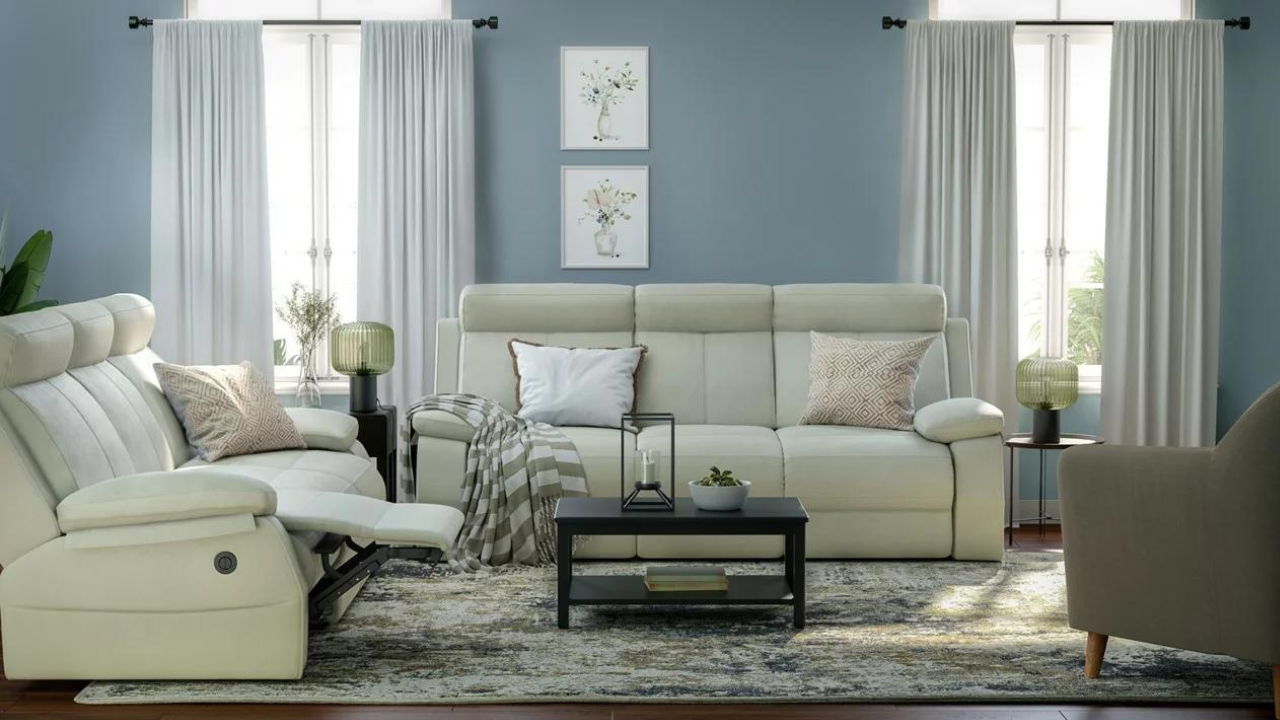
Whether you reside in a spacious home or a cosy apartment, you can create a living room that is not only visually captivating but also a haven of comfort and practicality. With this blog, you can redefine the essence of your living area, and turn it into a reflection of your personal taste and contemporary living.
7 Trendy Ideas for Living Room Furniture
-
Fusion of Global Cultures
Blending global cultures into living room design is an emerging trend that brings a rich and eclectic mix of aesthetics to your home. This approach is rooted in ‘cultural fusion’, where pieces from various parts of the world coexist harmoniously in one space, creating a unique and cosmopolitan ambience.
Imagine a living room where a sleek Scandinavian sofa sits alongside a vibrant Moroccan rug; or a space where traditional Japanese minimalism meets the bold textures of African art. Each piece tells a unique story – creating conversations around its origin, history, and cultural significance. This trend is not just about aesthetics; it celebrates global heritage and diversity. Integrating such diverse elements requires a thoughtful approach to ensure the space remains cohesive and balanced.
The key is finding a common thread – colour, material, or design style – that ties the different cultural elements together. For instance, a colour palette can be drawn from an Asian-inspired silk tapestry, informing the choice of hues for other furnishings in the room. Similarly, natural materials like wood, bamboo, or rattan can create unity in diverse pieces.
-
High-Tech and Futuristic Furniture
This trend goes beyond the traditional concept of furniture pieces as mere functional items – transforming them into interactive and smart features that offer unprecedented convenience and a glimpse into the future of interior design. Picture a living room where the furniture is not just about sitting or storage but about enhancing the quality of life through technological integration.
For instance, sofas and armchairs with built-in speakers, wireless charging pads, and touch-screen controls offer comfort and connectivity. Imagine coffee tables that double up as computing surfaces where you can browse the internet, control your smart home devices, or entertain guests with interactive games.
This fusion of technology and furniture design transcends mere gadgetry; it is an art form that creates pieces that are as aesthetically pleasing as they are technologically advanced. The design language of this trend leans towards sleek lines, minimalist forms, and a palette that complements the latest in tech innovation. Materials like tempered glass, polished metal, and high-grade plastics are often used to give these pieces a modern and sophisticated look.
-
Aromatherapy-infused Furniture
This integration of aromatherapy into furniture design represents a shift towards a more holistic approach in home decor, where the focus is not just on the visual or tactile, but also on the olfactory experience. The scents are usually released in controlled amounts – ensuring they are not overwhelming, but a subtle background note that enhances the living environment.
The technology behind this trend can range from simple, like embedding scented microcapsules into the fabric, to more advanced methods such as integrated diffusers that can release different scents based on user preference or even the time of day.
-
Artistic and Avant-garde Pieces
Avant-garde furniture often challenges traditional forms and materials – offering unconventional shapes, vibrant colours, and unexpected textures. Imagine a living room where a sofa is not just a seating option but a sculptural statement – with flowing lines and organic forms inspired by nature or abstract art.
Chairs might feature asymmetrical designs or be made from materials like repurposed industrial parts or experimental composites, pushing the boundaries of what furniture can be. Tables could double as interactive installations, with surfaces that respond to touch or change appearance under different lighting. -
Digital Art Displays
Unlike traditional static art pieces, digital displays provide a versatile canvas that can adapt to suit changing tastes, moods, or design needs. Envision a sleek, high-resolution screen adorning your living room wall, where the artwork displayed can change with the click of a button. These displays can showcase a vast array of digital artworks – from classic masterpieces to contemporary digital creations, personal photos, or even moving images.
This technology brings a new level of interactivity and personalisation to home decor. Homeowners can curate their art collection – switching styles or artists depending on the occasion or their current aesthetic preference. Moreover, some digital art platforms offer subscriptions to vast libraries of artwork, ensuring that the options for display are always fresh and exciting.
-
Multi-Sensory Experience
Soft, plush textures invite touch, while visual harmony is achieved through a carefully selected colour palette that soothes or stimulates depending on the desired mood. Sound is another crucial element. Acoustically optimised furniture dampens unwanted noise, while state-of-the-art sound system fills the room with immersive music, natural sounds, or the subtle ambient noise of a water feature.
Lighting plays a pivotal role in this sensory orchestra, with the capability to instantly transform a room’s atmosphere. Advanced lighting systems can mimic natural light cycles, helping to regulate our circadian rhythms or provide dynamic lighting scenes that change to reflect the time of day or the mood of the moment.
-
Space-saving and Transformative Designs
Consider a Murphy bed that folds into the wall, revealing a fold-down desk or shelving unit for daytime use – perfect for studio apartments. Modular sofas, which can be rearranged into different configurations or converted into guest beds, offer flexibility for everyday use and hosting.
Nesting tables and stackable stools are practical – these provide extra surface or seating when needed and can be tucked away neatly when unused. Opt for wall-mounted, drop-leaf, or extendable dining tables that can be expanded for guests and retracted for daily use. Vertical storage solutions – such as tall, slender shelving units or hanging storage options – utilise wall space effectively and keep the floor open & airy.
Innovative kitchen solutions, such as a rolling island that doubles up as a dining table or extra counter space, can dynamically adapt to cooking and dining needs. These space-saving and transformative design concepts are practical for compact living spaces, and they add a modern, minimalist aesthetic – creating a living environment that feels open, organised, and stylish.Read More: Living Room Decor Ideas
Conclusion
The trends and ideas that we have explored in this blog offer a glimpse into how you can infuse style, functionality, and personality into your living area. Whether you embrace a single trend or blend several, the key is to create a living room that feels right for you – a space that is welcoming, comfortable, and above all, a true representation of your unique style. Remember, the best living space is the one that resonates with your personal story and becomes a backdrop for the memories you create within its walls.







